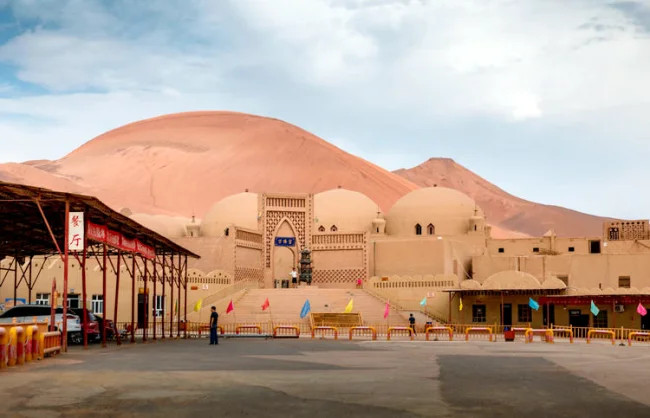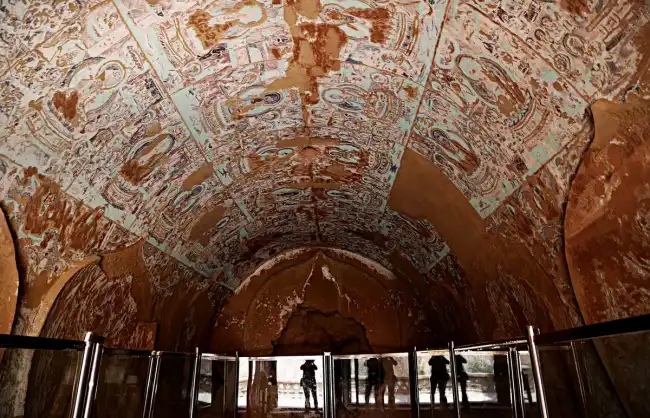Written by Veronica |
Carved into the cliffs of Mutou Valley deep, where the Flaming Mountains cast their fiery glow over the desert, the Bezeklik Thousand Buddha Caves whisper fading stories of unnamed devotion, ethereal art, and time’s relentless passage. For thousands of years, she has fought to preserve the most blissful dreams of our ancestors from being erased by time and human hands. Once a thriving Buddhist sanctuary along the China Silk Road, this remarkable site near Turpan in Xinjiang carries a legacy of cultural fusion, where Persian, Indian, and Chinese influences intertwined in vibrant murals—now softened by centuries of wind and sand.
Today, travelers from around the world still weep their eyes for her enduring beauty, which stands resilient against the scars of time and destruction. Whether you’re a history enthusiast or an art lover, you will catch a glimpse into a lost, yet mesmerizing world—where you can find vivid scenes from the life of Buddha as well as images of other important religious figures and symbols. The Bezeklik Caves are also an important archaeological treasure, designated as a UNESCO World Heritage Site.
Quick Facts of Bezeklik Caves
- Location:Bezeklik Thousand Buddha Caves is located in the Flaming Mountains near Turpan City, Xinjiang, China.
- Travel essentials:Bring water, sunscreen, and comfortable walking shoes.
- Area:Approximately 1200 square meters.
- Time Needed:Around 1-2 hrs.
- Highlights:Home to 77 rock-cut caves, with the largest spanning 42 meters in length and 13 meters in width. Notable sites include Caves No. 18, 20, 33, 38, as well as Grottoes 82 and 83 (detailed introductions to follow).
- Entrance fee:20
- Best For:History buffs, art lovers, and explorers drawn to the cultural echoes of the Silk Road.

What to See and Do When Visiting Bezeklik Caves
A Glimpse into the Past and Her Fate
Dating back to the 5th century (A.D. 499 – 640), the Bezeklik Thousand Buddha Caves were first excavated. Caves No. 18, 29 and 48 were built in this time, No. 18 being the earliest existing cave with murals can be seen. The cave flourished under the Gaochang Kingdom (5th–7th centuries) and continued to evolve through the Tang, Five Dynasties, Song, and Yuan periods for seven hundreds years in history.
Approximately a century ago, German explorer Albert von Le Coq’s expedition reached the Bezeklik Thousand Buddha Caves, only to find them buried in sand and inhabited by nomads. As the team archaeologists cleared away the deep layers of sand, they were enveloped by waves of color and stunned to see a long-forgotten tale gradually revealing itself on the walls. As von Le Coq himself described, they discovered “splendid paintings in colors as fresh as if the artist had only just finished them” (translated from Auf Hellas Spuren in Ostturkistan: vol.1).
Despite her grandeur, the Bezeklik Thousand Buddha Caves have endured centuries of hardship in history. The arrival of Islam led to the decline of Buddhism, and as a part of Buddhist cave temples, some murals were defaced, their figures’ eyes and mouths deliberately removed. In the early 20th century, 90% of the murals were cut from the caves and transported abroad by international expedition teams due to their survey methods, now collected at museums in other nations like Germany, Japan and Britain.
Discover the Masterpiece of Cross-Cultural Art
The Uighur word “Bezeklik” means “a place with paintings” or “a beautifully decorated place.” The murals of Bezeklik Caves are a testament to the Silk Road’s vast cultural exchanges. Traders, monks, and travelers from distant lands like Persia and India once converged here in ancient Turpan, their artistic heritage reflecting a multiethnic tapestry that slowly unfolds to invite interpretation. Chinese painting techniques (baimiao, 白描) blend seamlessly with foreign religious and symbolic traditions, resulting in a unique and vivid aesthetic.
The murals, spanning over 1,200 square meters, are breathtaking in both scale and detail. Monks, kings, celestial beings, and common worshippers gaze out from walls painted with intricate Buddhist narratives. One of the most significant murals in Cave 33 portrays Buddha’s Nirvana, where mournful disciples surround the reclining figure in a moment of reverent sorrow. Meanwhile, Cave 20 preserves rare depictions of the Uighur royal family, the rulers who once patronized these sacred halls.
Learn about Buddhism and Buddhist Uyghurs
Bezeklik Thousand Buddha Caves were named “Ningrong Temple” (宁戎寺) in the Tang Dynasty. For those interested in Buddhism, the Bezeklik Thousand Buddha Caves offer a wealth of research opportunities. Once nearly 83 in number, with 57 still surviving, these caves served as a spiritual and artistic hub for the thriving Buddhist communities of the region. Each figure features distinct facial features, attire, and adornments.
Cave 38 presents scenes from the life of ancient Manichaeism, while Grottoes 82 and 83 are small commemorative spaces specially built for Buddhist monks during the Gaochang period. The most notable mural in the Bezeklik Caves is the large mural known as the “Praṇidhi Scene,” named by the German expedition team. This mural is believed to depict Sakyamuni’s “promise” or “praṇidhi” from his past life. Although carefully collected by Albert von Le Coq and once exhibited in the Berlin Ethnological Museum, it was tragically destroyed during the Allied bombing of Berlin in World War II. The only remnants of this masterpiece are photographs and plates that survived the devastation.

Find Your Personal Ways to Connect
The Bezeklik Thousand Buddha Caves offers stunning open views of the canyon of Flamming Mountain in Turpan. For a unique experience, you can consider a camel ride through the surrounding desert, immersing yourself in the tranquil landscape. Although photography is prohibited inside the caves, you can unleash your creativity by sketching the memorable murals onto your notebooks. Some travelers find joy in drawing directly from these ancient artworks. Anyway, standing where monks once prayed and artists once painted, you will truly feel how time has left its mark.
Best Time to Visit
The best time to visit Bezeklik Thousand Buddha Caves is during the months of April to October, when the weather is generally mild and pleasant, making it ideal for exploring the caves and the surrounding areas. However, this is also the busiest time, so if you prefer to avoid crowds and higher prices of accommodation, then November to March would be a good choice. During these months, the weather is cooler and there are fewer tourists, so you can enjoy a more peaceful and personal experience. See our Xinjiang travel guide for more details and top tips.
Bezeklik Caves Location & Transportation
Bezeklik Thousand Buddha Caves are located at the Flaming Mountain Area, Gaochang District, Turpan. 39 km from Turpan downtown, it is easily accessible. First, reach Turpan via the Lanzhou-Urumqi High-speed Railway or by flying from major cities like Lanzhou, Beijing, or Chengdu. From Turpan to the caves is about a 45-minute drive. The most convenient way to get there is by taxi, with round-trip fares ranging from CNY 150-200. Car rentals are available for CNY 300-400 per day. Alternatively, take a local bus to Shanshan County, then transfer to a tuktuk or shared taxi for the final leg. For a guided experience, consider joining a turpan tour with us to get rid of Language barriers.
Attractions Nearby Bezeklik Caves
Bezeklik Thousand Buddha Caves are located in a region rich in natural and cultural attractions. Some of the top attractions nearby include:
- Grape Valley:Grape Valley is a scenic area located near Flaming Mountains, known for its vineyards, fruit orchards, and natural beauty.
- Jiaohe Ancient City: Jiaohe Ancient City is an ancient Silk Road city located near Flaming Mountains, featuring well-preserved ruins and artifacts from the Han and Tang dynasties.
- Turpan Museum:Turpan Museum is a must-visit attraction for history buffs, featuring artifacts and exhibits related to the region’s rich cultural heritage.
Recommended Xinjiang Tours with Bezeklik Thousand Buddha Caves
The Bezeklik Thousand Buddha Caves, once ravaged and left with mere scraps of paintings, still evoke awe today. Despite their faded pigments and delicate brushstrokes on the cavern walls, the quiet hush of history lingers, making a visit to these caves a unique experience. Discover more about our itinerary for learning Bezeklik Thousand Buddha Caves history and dive into this unforgettable journey.







